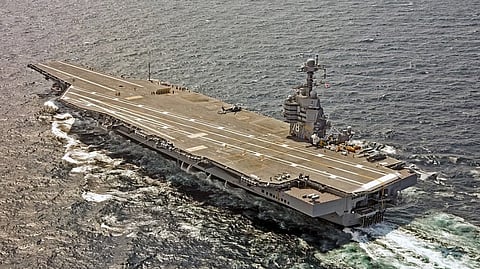

The Gerald Ford aircraft carrier strike group has moved into the Latin America region, US officials said on Tuesday, dramatically escalating a military buildup that has deepened tensions with Venezuela.
President Donald Trump ordered the deployment of the Ford last month, adding to the eight warships, a nuclear submarine and F-35 aircraft already in the Caribbean.
The Ford, which was commissioned in 2017, is the United States' newest aircraft carrier and the world’s largest, with more than 5,000 sailors aboard.
The Pentagon confirmed the arrival, which was first reported by Reuters, saying in a statement it would help, "disrupt narcotics trafficking and degrade and dismantle transnational criminal organisations." Venezuelan President Nicolas Maduro has repeatedly alleged that the US buildup is designed to drive him from power.
Washington in August doubled its reward for information leading to Maduro’s arrest to $50 million, accusing him of links to drug trafficking and criminal groups that Maduro denies.
The US military has carried out at least 19 strikes so far against drug vessels in the Caribbean and off the Pacific coasts of Latin America, killing at least 76 people.
When the US first announced the Ford’s deployment, Maduro warned that if the US ever intervened in the country, "millions of men and women with rifles would march across the country."
Venezuela is deploying weapons, including decades-old Russian-made equipment, and is planning to mount a guerrilla-style resistance or sow chaos in the event of a US air or ground attack, according to sources with knowledge of the efforts and planning documents seen by Reuters.
Tensions between the United States and Venezuela’s neighbour, Colombia, have also spiked in recent weeks, with Trump and Colombian President Gustavo Petro trading barbs. Trump has called Petro an "illegal drug leader" and imposed sanctions on him. The leftist Colombian president has accused the US of committing "murder" with its strikes.
A Reuters visual investigation found the US military is upgrading a long-abandoned former Cold War naval base in the Caribbean, suggesting preparations for sustained operations that could help support possible actions inside Venezuela.
The deployment of the Ford, however, is a far more overt demonstration of US military readiness. With only 11 aircraft carriers in the US military’s arsenal, they are a scarce resource and their schedules are usually set well in advance - making the Trump administration’s surprise announcement last month unusual.
The Ford carrier, which includes a nuclear reactor, can hold more than 75 military aircraft, including fighter aircraft like the F-18 Super Hornet jets and the E-2 Hawkeye, which can act as an early warning system.
The Ford also includes sophisticated radars that can help control air traffic and navigation.
The supporting ships, such as the Ticonderoga-class guided missile cruiser Normandy, Arleigh Burke-class guided missile destroyers Thomas Hudner, Ramage, Carney, and Roosevelt, include surface-to-air, surface-to-surface, and anti-submarine warfare capabilities.
(Reporting by Phil Stewart and Idrees Ali, Editing by Franklin Paul and Nick Zieminski)
